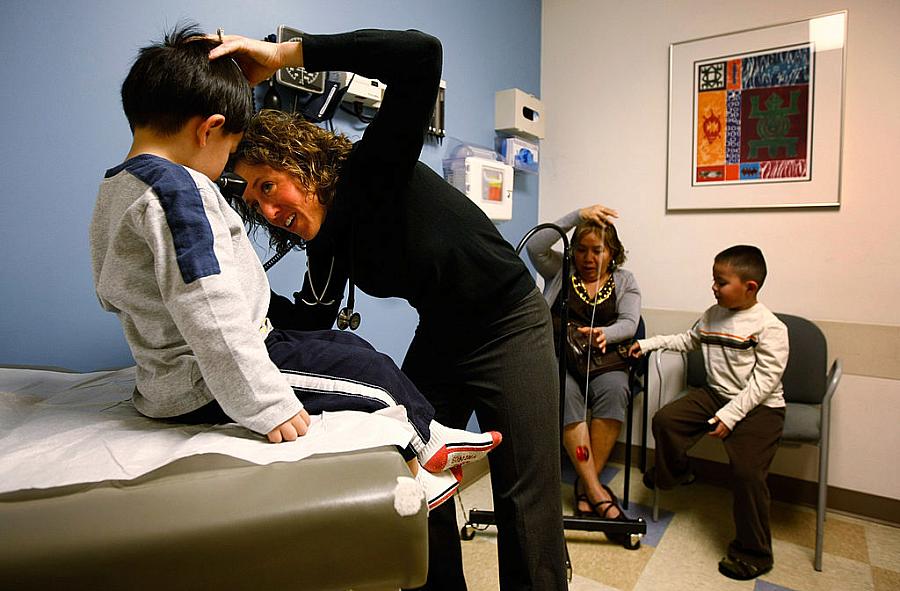Annual report on children’s well-being finds some good news

Photo: John Moore/Getty Images
For reporters covering children’s health, the annual Data Book from KIDS COUNT is a bankable resource. With seasonal regularity, you can count on a bevy of stories localizing the annual report.
The 2016 report, published by the Annie E. Casey Foundation, landed on Tuesday, and a quick dip in Google News already shows over 160 hits from outlets in every corner of the country. As you might expect, states’ reports cards vary widely, with headlines ranging from downright glum (“N.M. again at bottom of states for child wellness”) to guardedly optimistic (“Montana ‘Most Improved’ In Child Well-Being Rankings”). Minnesota took the lead in this year rankings for overall children’s health (last year it was Iowa), while Louisiana pulls up the rear (last year it was Mississippi).
But at the national level, the news on children’s health from this year’s report is largely positive. Rates for teen substance abuse, uninsured children and child deaths are all down modestly from the previous year (the reports have a two-year lag — the 2016 report is based on 2014 data). Rates of babies born with low birth-weights are unchanged from 2013 data, still representing about 8 percent of births overall (but nearly 13 percent of African-American babies). Gains in children’s health coverage are the most notable finding, with rates of uninsurance down 40 percent from 2008:
The largest improvement was in the rate of children without health insurance. Fewer children lacked access to health insurance coverage in 2014 than before the recession, despite higher unemployment and a decline in employer-sponsored health insurance coverage during the past several years.
Big racial disparities exist here, too, but this time it’s American Indian (14 percent) and Latino (10 percent) kids who lack coverage at higher rates, compared with white and black kids (around 5 percent uninsured).
If that’s the good news on children’s health, then the bad news is that child poverty was stuck at 22 percent in 2014, unchanged from the previous year. That’s compared with 18 percent in 2008. The report also finds that 14 percent of children live in high-poverty areas, compared with 11 percent from 2006-2010. And while the rate of suicide for teen boys is the same in 2014 as it was in 2000 at 13 per 100,000, the rate for teen girls has nearly doubled since 2007, going from 2.4 to 4.2 per 100,000.
But overall, the report’s findings on trends in children’s health are encouraging. If that sound vaguely familiar, it may be because last week The New York Times’ Margot Sanger-Katz published a story — “Good News Hidden in the Data: Today’s Children Are Healthier” — with very similar conclusions, though based on different data sources and a longer time horizon. Sanger-Katz writes:
The health of American children is improving sharply, and the health gap between the rich and the poor among children and young adults is shrinking. The research suggests that future generations of Americans may not reach old age with the same ailments and inequalities as today’s older Americans.
That broad assertion rests in part on a new study published in April in the journal Science by Princeton economist Janet Currie and European economist Hannes Schwandt. In the study, they report that the death rate for children is dropping even faster in poor U.S. counties than in richer ones:
For children and young adults below age 20, however, we find strong mortality improvements that are most pronounced in poorer counties, implying a strong decrease in mortality inequality. These younger cohorts will form the future adult U.S. population, so this research suggests that inequality in old age mortality is likely to decline in [the] future.
For middle-aged adults, the story is still very different. But for children, the gains detailed by the latest KIDS COUNT report as well as the longer-term research on child mortality suggest some reasons for optimism.
Given the privileged role early childhood plays in setting up later-in-life health, it’s reasonable to expect these improvements in kids’ health to keep paying dividends as they mature into adults in the decades to come. Momentum is always tenuous, but it appears to be going in the right direction.
**

